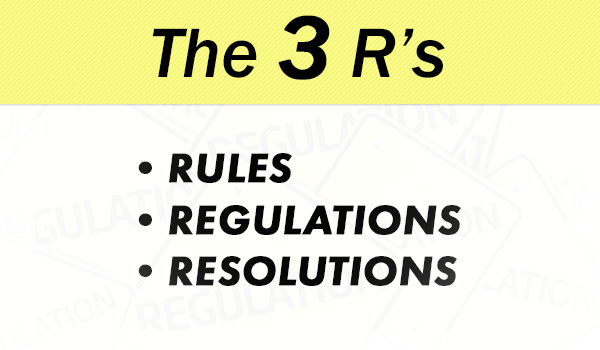When most people hear the term “the three R’s,” they probably think of the phrase “reduce, reuse, recycle” that they learned in grade school. But did you know that there are three R’s that apply to homeowner associations, too? Rules, regulations, and resolutions are a core part of every HOA and they help define the standards of the community.
Because amending bylaws is pretty tedious and difficult for HOA boards, the rules, regulations, and resolutions that define policies and procedures of the association are often designed to be flexible. They’re rarely specifically defined in the governing documents. This allows the board to modify them on an as-needed basis for the community without having to deal with the red tape of amending bylaws.
Even though it might seem like these three R’s are mostly the same thing, there are actually some important differences that HOA boards need to be aware of. Rules and regulations are used by the association to define rules of conduct for the community. Resolutions, on the other hand, are the preferred method of establishing procedures for the association.
Let’s take a closer look the role that rules and regulations play in the three R’s of HOAs:
Rules and Regulations
Rules and regulations can also be considered guidelines for a particular association in regard to rules of conduct. They:
- Define expected behaviors of residents and guests in the community
- Identify limitations of actions for residents and guests
- Are adopted by the board
- Must not contradict the governing documents
- Are enforceable in court
Typically, rules and regulations address topics like hours of operation, pets, parking, noise, restrictions, or guest use limitations. Some specific examples of rules and regulations include:
- Restricting the type, size, or breed of pets allowed for members living the community
- Outlining the expectations for lawn, tree, or shrubbery maintenance in front yards
- Limiting the number of parking spots allotted to each individual residence
- Defining appropriate home modifications for paint colors, additions, or accessories
- Enforcing fees for violations of HOA rules, if not already defined in the governing documents
Establishing, enforcing, and amending rules and regulations is an important task for every HOA board to ensure that policies and procedures within the community run smoothly. And while boards have the power to add or change these rules and regulations without involving owners in a vote, remember that it’s usually a good idea to at least seek input from owners first to increase the chances that they’ll comply.
Related: How to Deal With Hoarding in Your HOA Community
We hope this has helped you understand a bit better what rules and regulations mean to your HOA board. In our next post, we’ll continue with the three R’s and look at the specifics of HOA resolutions.







